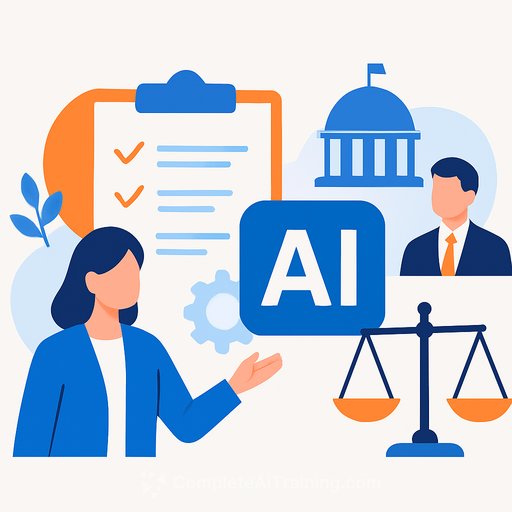South Korea moves to defuse AI-copyright conflicts: What government teams can do now
South Korea's National Assembly Research Service has urged immediate government action to reduce conflicts between copyright holders and AI developers. In its Nov. 13 report, the agency proposes clear compensation models, principles for distribution, standard contract terms, procedures for data use, mandatory disclosure of training data, and a permanent consultation body linking the Ministry of Science and ICT with the Ministry of Culture, Sports and Tourism.
The message is simple: set the rules, make them enforceable, and give both creators and developers a predictable path to compliance.
Why this matters for policymakers
Courts are being asked to solve policy gaps case by case. That's slow, expensive, and inconsistent. A government-led framework can lower disputes, protect creative markets, and give AI developers legal certainty to build responsibly.
Core recommendations at a glance
- Define compensation models for using copyrighted works in AI training.
- Set principles for distributing payments to rightsholders.
- Publish standard contract terms for data licensing and AI training.
- Establish clear procedures for lawful data collection, storage, and use.
- Require disclosure of training data sources and methods.
- Create a permanent inter-ministry consultation framework (Science and ICT + Culture, Sports and Tourism).
Practical steps agencies can take now
- Stand up a joint task force with a 180-day mandate to draft rules, model terms, and enforcement options.
- Launch a consultation schedule with creators, CMOs, platforms, AI labs, libraries, and research bodies.
- Publish a "model license pack": short-form, standard, and enterprise clauses that agencies and SOEs can adopt.
- Pilot a dataset registry and model cards for public-sector AI projects to prove feasibility of disclosure.
- Design a compensation calculator with transparent inputs (usage, repertoire size, dataset weight, commercial intent).
- Propose incentives (reduced fees, sandbox status) for early compliance and penalties for non-disclosure.
Designing a compensation model
Pick a structure that fits market realities and can scale. Options include a statutory license with published tariffs, a collective management approach with a clearinghouse, or a hybrid with sector-specific rates. For distribution, use verifiable proxies: catalog coverage, detected matches, usage logs, and certified sampling.
Carve-outs can cover research uses with strict safeguards. For small developers, consider capped fees or tiered rates. Build audit rights, reporting duties, and dispute resolution into the base rules to avoid case-by-case litigation.
Data-use procedures and disclosure that work
- Provenance logging: require dataset manifests, source URLs, license status, and crawl methods.
- Privacy and safety: mandate data minimization, PII filtering, and security controls for sensitive corpora.
- Tiered transparency: public summaries for all; detailed lists in a secure portal for regulators; confidential annexes for auditors when needed.
- Retention limits: define how long raw data and intermediate copies can be kept.
- Independent audits: certify compliance annually for high-impact models.
Standard contract terms: a practical starter list
- Scope of use: training, fine-tuning, evaluation, and synthetic data rules.
- Prohibited content: PII, sensitive categories, and restricted sectors.
- Attribution and notices: disclosure of sources and rightsholder acknowledgments where feasible.
- Compensation: rate structure, reporting frequency, and payment timelines.
- Data handling: security, deletion, and incident reporting.
- Audit rights and remedies: cure periods, suspension, and termination.
- Jurisdiction and dispute resolution: mediation first, then arbitration/courts.
Governance and measurement
- Key metrics: share of models with full dataset manifests; audit pass rates; time to resolve disputes; distribution lag to rightsholders.
- Compliance tiers: bronze/silver/gold badges tied to benefits (faster approvals, reduced fees).
- Public reporting: quarterly dashboards to maintain trust with creators and developers.
International alignment
Interoperability reduces friction for cross-border AI projects. Align disclosure definitions and licensing signals with international bodies where possible.
A workable 180-day timeline
- Days 1-30: Form the inter-ministry task force; publish a consultation paper; open a call for evidence.
- Days 31-90: Draft compensation model options, standard clauses, and disclosure templates; run pilots with volunteer labs and CMOs.
- Days 91-150: Refine based on pilot data; set audit criteria and enforcement levers; align with competition and privacy regulators.
- Days 151-180: Publish the final framework; announce compliance timelines and incentives; launch the dataset registry.
Bottom line for public officials
The report sets a clear path: make compensation predictable, make data practices visible, and keep the relevant ministries at the same table. Do that, and you reduce disputes while giving AI developers a clean way to build with confidence.
Optional upskilling for government teams
If your department needs practical training on AI use cases, risk, and oversight, explore role-based learning paths: courses by job.
Your membership also unlocks:






